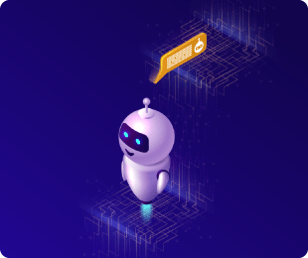Table of Content
TABLE OF CONTENTS

In recent years, artificial intelligence has made its way into nearly every conversation about the future of customer experience (CX). While headlines often focus on the hype, promising everything from instant resolutions to fully automated service, the real question facing organizations today is more practical: How do we move from AI theory to AI impact?
One of the most exciting developments in this space is Agentic AI — a new generation of AI-powered systems designed not just to automate tasks but to act with purpose, context, and adaptability. With Agentic AI, the gap between technology and meaningful customer outcomes is finally starting to close.
Understanding Agentic AI in the CX landscape
At its core, Agentic AI refers to AI systems that can operate as autonomous agents within business processes. Unlike traditional automation tools that follow fixed rules, Agentic AI systems have the ability to reason, adjust, and make decisions based on context.
In the CX world, AI can now go beyond simple tasks like answering FAQs or routing tickets. It can:
- Understand the intent behind customer interactions
- Provide personalized responses
- Collaborate with human agents in real time
- Navigate across multiple channels and systems
This shift transforms how organizations approach service delivery, customer engagement, and operational efficiency.
Top challenges in today’s CX operations
Top CX challenges include difficulty reaching live agents, unhelpful automated platforms, lack of personalization, data overload, and the need for continuous learning. Agentic AI can address these by automating routine tasks, providing personalized experiences based on data, and ensuring a seamless transition between AI and human support.
| CX Challenge | Description | Impact on Customer Experience |
|
Difficulty Reaching Live Agents |
Customers face long wait times or complex IVRs before speaking to a human. | Leads to frustration, decreased satisfaction, and potential customer churn. |
|
Unhelpful Automated Platforms |
Chatbots or voice bots often fail to resolve complex queries. |
Increases effort for customers, causing dissatisfaction and repeated contacts. |
| Lack of Personalization | Interactions are generic, not tailored to customer history or preferences. |
Reduces engagement, loyalty, and perceived value of the brand. |
| Data Overload | Agents and systems are overwhelmed by siloed or excessive customer data. |
Slows down response times, increases error rates, and reduces service quality. |
| Need for Continuous Learning | CX teams struggle to stay updated with new tools, protocols, or customer needs. |
Results in inconsistent service and missed improvement opportunities. |
How Agentic AI is transforming CX
Agentic AI revolutionizes customer experience by enabling proactive, personalized, and efficient interactions. It goes beyond traditional chatbots by learning from past interactions, adapting responses dynamically, and making autonomous decisions, ultimately mimicking human-like engagement. This AI empowers businesses to offer instant support, break language barriers, personalize experiences at scale, and resolve complex queries with minimal human intervention.
Here's how Agentic AI transforms customer experience:
Proactive and personalized support
- Predictive insights: Agentic AI analyzes customer data to anticipate needs and proactively offer solutions before issues escalate.
- Personalized interactions: AI agents tailor responses based on individual customer preferences and past interactions, fostering a sense of understanding and value.
- Contextual recommendations: AI provides relevant recommendations and guidance during customer interactions, improving satisfaction and reducing resolution times.
Enhanced efficiency and automation
- Instant support: Agentic AI provides 24/7 support, reducing wait times and improving customer satisfaction.
- Automated tasks: AI handles routine tasks like scheduling, processing orders, and providing product information, freeing up human agents to focus on complex issues.
- Optimized operations: Agentic AI can optimize workflows, resource allocation, and task assignment, leading to increased efficiency and productivity.
Breaking down barriers and expanding reach
- Multilingual support: Advanced language models allow AI agents to communicate in multiple languages, breaking down geographical and language barriers.
- Complex query resolution: Agentic AI excels at resolving multi-step, complex queries, learning from each interaction and improving its ability to address challenges autonomously.
- Seamless integration: AI can integrate with various systems and channels, providing a unified and consistent customer experience.
Data-driven decision-making
- Proactive problem-solving: Agentic AI identifies trends and patterns by analyzing customer data, acting as an early warning sign for potential issues.
- Improved service quality: AI agents proactively collect and analyze interaction data, leading to better service quality and resource optimization.
- Continuous learning: Agentic AI continuously learns from customer interactions, improving its ability to provide personalized and effective support over time.

Real-world use cases driving value
Organizations across industries are starting to see tangible results from Agentic AI. Some key examples include:
- Chat-based AI agents handle a wide range of inquiries, from product recommendations to troubleshooting, without human intervention.
- Voice-enabled AI that supports customers on the phone, capturing intent and providing accurate responses while handing off complex issues to human agents.
- CRM integrations where AI automatically updates Salesforce or ServiceNow records, ensuring that data stays consistent and up to date across channels.
These use cases not only improve efficiency but also drive better customer outcomes.
Practical steps to get started with Agentic AI
To begin with, Agentic AI in CX, start by defining clear objectives and use cases, focusing on specific problems Agentic AI can solve. Assess your organizational readiness, ensuring your technology stack can integrate with Agentic AI solutions. Prioritize data quality and availability by collecting, cleaning, and organizing relevant datasets. Build a cross-functional team to facilitate collaboration and implementation.
Here's a more detailed breakdown:
Define clear objectives and use cases
- Identify problems: What specific customer experience issues do you want to address with Agentic AI? Examples include automating customer support, personalizing recommendations, or improving product knowledge.
- Prioritize: Start with high-impact, low-risk applications to gain experience and demonstrate the value of Agentic AI.
- Set measurable goals: Define how success will be measured (e.g., reduced resolution times, increased customer satisfaction, decreased operational costs).
Assess organizational readiness
- Evaluate your technology stack: Determine if your existing systems are compatible with Agentic AI solutions.
- Identify integration needs: Plan how Agentic AI will integrate with your CRM, customer service platforms, and other systems.
- Assess team skills: Identify any training needs to equip your team with the necessary skills for implementing and managing Agentic AI.
Ensure data quality and availability
- Collect and clean data: Gather relevant customer data (e.g., demographics, purchase history, interaction logs) and ensure it's accurate and consistent.
- Address data silos: Identify and resolve any issues with data access and sharing across different departments.
- Consider data privacy: Adhere to all relevant data privacy regulations (e.g., GDPR, CCPA).
Build a cross-functional team
- Involve key stakeholders: Include representatives from IT, customer service, marketing, sales, and other relevant departments.
- Define roles and responsibilities: Establish clear roles and responsibilities for each team member to ensure effective collaboration.
- Foster communication: Implement a robust communication plan to keep everyone informed and engaged.
Pilot and iterate
- Launch pilot projects: Begin with a small-scale pilot project to test the feasibility and effectiveness of Agentic AI.
- Gather feedback: Collect feedback from both human agents and customers to identify areas for improvement.
- Iterate and refine: Use the feedback to refine the Agentic AI system and improve its performance.
Conclusion
The conversation around AI in CX is evolving. We are moving beyond curiosity and experimentation toward a future where AI is central to delivering faster, smarter, and more human-centered customer experiences.
The question is no longer whether to embrace Agentic AI — it’s how to do it effectively.
If you’re ready to explore how Agentic AI can deliver real CX results in your organization, join our upcoming webinar. We’ll unpack real-world use cases, show live demos, and share practical steps to help you accelerate your AI journey. Register now!
-2.jpg?width=240&height=83&name=Menu-Banner%20(5)-2.jpg)
.jpg?width=240&height=83&name=Menu-Banner%20(8).jpg)

